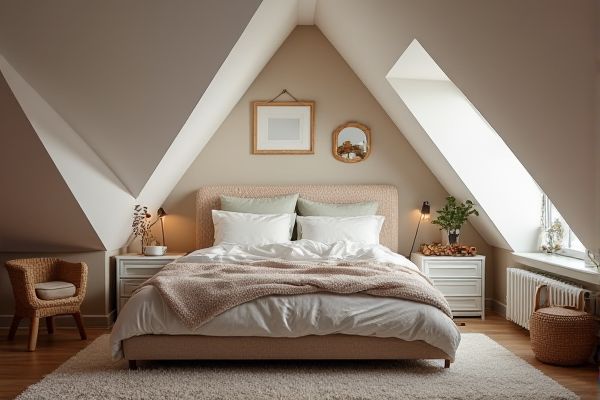
An attic bedroom offers a cozy, private sleeping space tucked under the eaves, maximizing comfort with minimal furnishings, while an attic studio provides a versatile, open-plan area ideal for creative work or multi-functional use, often requiring more thoughtful design for lighting and storage. Discover which attic conversion best suits Your lifestyle and needs by exploring the full comparison in the rest of the article.
Table of Comparison
| Feature | Attic Bedroom | Attic Studio |
|---|---|---|
| Primary Use | Sleeping and resting area | Workspace or creative area |
| Furniture | Bed, nightstands, wardrobe | Desk, shelves, seating |
| Lighting | Soft, ambient lighting | Bright, task-focused lighting |
| Sound Isolation | Moderate; designed for comfort | High; reduces distractions |
| Storage | Closets or under-bed storage | Organized shelves and cabinets |
| Design Focus | Cozy, relaxing atmosphere | Functional, inspiring environment |
| Floor Space Usage | Maximized for sleeping comfort | Optimized for productivity |
| Typical Ceiling Height | Varies; comfortable for lying down | Higher clearance preferred for movement |
| Examples of Usage | Guest room, children's bedroom | Art studio, home office |
Introduction to Attic Bedrooms and Attic Studios
Attic bedrooms utilize the existing roof space primarily for sleeping quarters, offering cozy, private areas often featuring sloped ceilings and dormer windows. Attic studios transform the attic into versatile workspaces or creative hubs, maximizing natural light and open layouts for productivity. Both designs optimize underused attic space but serve distinct purposes tailored to residential comfort or functional workspace needs.
Key Differences: Attic Bedroom vs Attic Studio
An attic bedroom is primarily designed for sleeping and relaxation, typically featuring a bed, storage, and minimal furnishings, whereas an attic studio serves as a multifunctional workspace combining living, working, and sleeping areas. The attic studio maximizes open floor plans with desks, creative equipment, and seating, supporting productivity alongside comfort. Key differences include spatial layout, intended use, and furniture arrangement, with attic bedrooms emphasizing rest and attic studios fostering creativity and functionality.
Space Utilization and Layout Options
An attic bedroom typically maximizes space for sleeping and storage, offering a cozy, private retreat with built-in closets and under-eave storage solutions that make efficient use of sloped ceilings. An attic studio, in contrast, emphasizes open layout versatility, accommodating multifunctional areas such as workspaces, seating, and sleeping zones, with flexible furniture arrangements that adapt to changing needs. Both configurations optimize limited square footage, but the studio's design focuses on seamless integration of living and working environments, while the bedroom prioritizes comfort and rest.
Lighting: Maximizing Natural Light in Attics
Attic bedrooms benefit from strategically placed skylights and dormer windows that enhance natural light, creating a bright and inviting atmosphere ideal for rest. Attic studios require larger, unobstructed window spaces or multiple skylights to maximize daylight for productive work and creativity. Both spaces can incorporate light-colored walls and reflective surfaces to amplify natural illumination and reduce reliance on artificial lighting.
Privacy Considerations for Bedrooms and Studios
An attic bedroom offers enhanced privacy by being a dedicated sleeping area separated from common living spaces, ideal for restful environments and personal retreat. In contrast, an attic studio combines living, working, and sleeping areas into one open space, which can reduce privacy due to multifunctional use and limited partitioning. Careful design, such as installing room dividers or soundproofing, is essential in attic studios to optimize privacy and minimize disturbances.
Storage Solutions for Attic Spaces
Attic bedrooms benefit from built-in storage under eaves and custom closets that maximize limited vertical space while keeping the sleeping area clutter-free. Attic studios often incorporate multifunctional furniture and wall-mounted shelves to create an organized workspace without compromising room for creativity. Both designs capitalize on creative storage solutions like recessed cabinets and pull-out drawers to enhance usability in confined attic spaces.
Heating, Cooling, and Ventilation Challenges
Attic bedrooms often face significant heating, cooling, and ventilation challenges due to limited insulation and poor airflow, leading to uncomfortable temperature fluctuations. Attic studios require enhanced ventilation systems and strategic insulation to maintain consistent climate control for both comfort and productivity. You can improve energy efficiency and air quality by installing proper ventilation, radiant barriers, and HVAC-compatible solutions tailored to the attic's unique layout.
Design Styles: Cozy Bedroom vs Functional Studio
Attic bedrooms emphasize cozy design styles with warm lighting, soft textiles, and intimate layouts that maximize comfort in a smaller space. Attic studios prioritize functional design elements such as built-in storage, multipurpose furniture, and open floor plans to support productivity and creative activities. Both designs optimize the unique sloped ceilings and natural light but serve distinct purposes tailored to rest or work.
Cost Comparison: Remodeling an Attic
Remodeling an attic bedroom typically costs less than converting the space into an attic studio due to simpler requirements for electrical, plumbing, and layout modifications. Attic studios often demand higher investments because they need dedicated workspaces, enhanced lighting, and soundproofing to support productivity. Consider your budget and intended use carefully to determine whether a cost-effective attic bedroom or a more versatile but expensive attic studio suits your needs.
Choosing the Right Attic Conversion for Your Needs
An attic bedroom provides a cozy, private sleeping space ideal for families needing extra rooms, emphasizing comfort and insulation for year-round use. An attic studio, designed as a multifunctional work or creative area, prioritizes open layouts and natural light to foster productivity and inspiration. Selecting the right attic conversion depends on your lifestyle requirements, space utilization, and desired functionality, ensuring the renovation aligns with your personal or professional needs.
 homyna.com
homyna.com